Boaz Huss (born 1959) [1] is a professor of Kabbalah at the Goldstein-Goren Department of Jewish Thought at Ben-Gurion University of the Negev. He is a leading scholar in contemporary Kabbalah.
Boaz Huss (born 1959) [1] is a professor of Kabbalah at the Goldstein-Goren Department of Jewish Thought at Ben-Gurion University of the Negev. He is a leading scholar in contemporary Kabbalah.
Boaz Huss was born in Jerusalem, Israel. [1] He completed his undergraduate and graduate work at the Hebrew University of Jerusalem, where he earned a B.A. in Philosophy and History of Jewish Thought in 1986 and a Ph.D. in History of Jewish Thought in 1993. [2] His doctoral thesis, Ketem Paz – The Kabbalistic Doctrine of Rabbi Simeon Lavi in His Commentary to the Zohar, [3] was supervised by Professor Moshe Idel. [2]
He was a Fulbright post-doctoral fellow at Yale University (1993/4), a Starr fellow at the Center for Jewish Studies at Harvard University (2002), and a fellow at The Institute for Advanced Studies at The Hebrew University of Jerusalem (1998/9, 2008/9). [4] He lectured at Hebrew University (1994–1996) and Tel Aviv University (1995–1996) before coming to the Goldstein-Goren department of Jewish Thought at Ben-Gurion University; [5] he has chaired the department in 2010-2012. [6] He has received several research grants, including two 4-year grants from the Israel Science Foundation on the subjects of "Major Trends in 20th Century Kabbalah" (2005) and "Kabbalah and the Theosophical Society (1875-1936)". [7]
Huss is a board member of the European Society for the Study of Western Esotericism, and has served on the editorial boards of the Zohar Education Project in Chicago and the International Journal for the Study of New Religions. [6]
Huss' research interests cover the Zohar and its reception, modern and contemporary Kabbalah, Western esotericism, and the New Age. His first monograph was dedicated to the Kabbalah of Rabbi Shimon Lavi, one of the first commentators of the Zohar. In his second monograph he examined the reception of the Zohar and the construction of its symbolic value. Huss was one of the first scholars to "take seriously more contemporary expressions of Jewish mysticism that have been largely ignored by scholars". [8]
He has written about the communist Kabbalah of Rabbi Yehuda Ashlag, [9] about Kabbalistic motifs used by Madonna, [10] and about the New Age and postmodern characteristic of contemporary Kabbalah. [11] Huss also studied the history of Kabbalah research, and criticized the use of the term "mysticism" as the defining category of Kabbalah and Hasidism, and the theological framework of the academic study of Jewish mysticism. [12] He is widely quoted in contemporary Kabbalah literature. [13] [14] [15] [16]
In 2006 he appeared as himself in the TV movie "Decoding the Past: Secrets of Kabbalah", together with other Kabbalah scholars such as Michael Berg, Pinchas Giller, Moshe Idel, Daniel C. Matt, Ronit Meroz, and Byron Sherwin. [17]
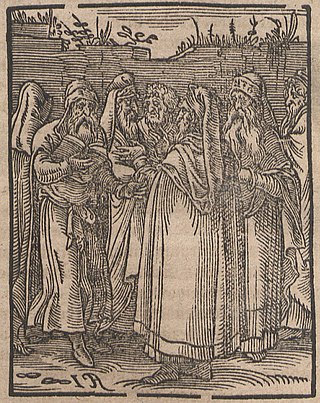
Kabbalah or Qabalah is an esoteric method, discipline and school of thought in Jewish mysticism. A traditional Kabbalist is called a Mekubbal. The definition of Kabbalah varies according to the tradition and aims of those following it. According to its earliest and original usage in ancient Hebrew it means 'reception' or 'tradition', and in this context it tends to refer to any sacred writing composed after the five books of the Torah. After the Talmud is written, it refers to the Oral Law. In the much later writings of Eleazar of Worms, it refers to theurgy or the conjuring of demons and angels by the invocation of their secret names. The understanding of the word Kabbalah undergoes a transformation of its meaning in medieval Judaism, in the books which are now primarily referred to as 'the Kabbalah': the Bahir, the Zohar, Etz Hayim etc. In these books the word Kabbalah is used in manifold new senses. During this major phase it refers to the continuity of revelation in every generation, on the one hand, while also suggesting the necessity of revelation to remain concealed and secret or esoteric in every period by formal requirements native to sacred truth. When the term Kabbalah is used to refer to a canon of secret mystical books by medieval Jews, these aforementioned books and other works in their constellation are the books and the literary sensibility to which the term refers. Even later the word is adapted or appropriated in Western esotericism, where it influences the tenor and aesthetics of European occultism practiced by gentiles or non-Jews. But above all, Jewish Kabbalah is a set of sacred and magical teachings meant to explain the relationship between the unchanging, eternal God—the mysterious Ein Sof —and the mortal, finite universe. It forms the foundation of mystical religious interpretations within Judaism.
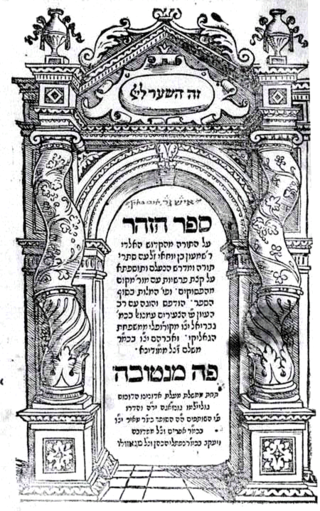
The Zohar is a foundational work of Kabbalistic literature. It is a group of books including commentary on the mystical aspects of the Torah and scriptural interpretations as well as material on mysticism, mythical cosmogony, and mystical psychology. The Zohar contains discussions of the nature of God, the origin and structure of the universe, the nature of souls, redemption, the relationship of ego to darkness and "true self" to "the light of God".

Isaac ben Solomon Luria Ashkenazi, commonly known in Jewish religious circles as Ha'ari, Ha'ari Hakadosh or Arizal, was a leading rabbi and Jewish mystic in the community of Safed in the Galilee region of Ottoman Syria, now Israel. He is considered the father of contemporary Kabbalah, his teachings being referred to as Lurianic Kabbalah.
Academic study of Jewish mysticism, especially since Gershom Scholem's Major Trends in Jewish Mysticism (1941), draws distinctions between different forms of mysticism which were practiced in different eras of Jewish history. Of these, Kabbalah, which emerged in 12th-century southwestern Europe, is the most well known, but it is not the only typological form, nor was it the first form which emerged. Among the previous forms were Merkabah mysticism, and Ashkenazi Hasidim around the time of the emergence of Kabbalah.
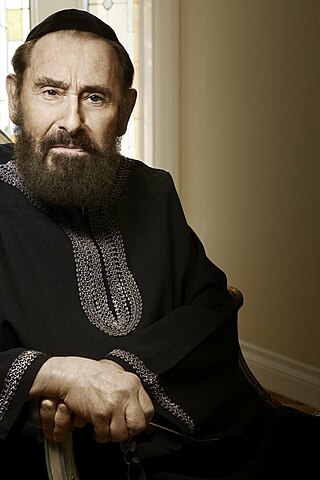
Philip S. Berg was an American rabbi and dean of the worldwide Kabbalah Centre organization.

Jewish meditation includes practices of settling the mind, introspection, visualization, emotional insight, contemplation of divine names, or concentration on philosophical, ethical or mystical ideas. Meditation may accompany unstructured, personal Jewish prayer, may be part of structured Jewish services, or may be separate from prayer practices. Jewish mystics have viewed meditation as leading to devekut. Hebrew terms for meditation include hitbodedut or hitbonenut/hisbonenus ("contemplation").
Lurianic Kabbalah is a school of Kabbalah named after Isaac Luria (1534–1572), the Jewish rabbi who developed it. Lurianic Kabbalah gave a seminal new account of Kabbalistic thought that its followers synthesised with, and read into, the earlier Kabbalah of the Zohar that had disseminated in Medieval circles.
The primary texts of Kabbalah were allegedly once part of an ongoing oral tradition. The written texts are obscure and difficult for readers who are unfamiliar with Jewish spirituality which assumes extensive knowledge of the Tanakh, Midrash and halakha.
Jonathan Garb is an Israeli scholar of Kabbalah. He is holder of the Gershom Scholem chair in Kabbalah in the Department of Jewish Thought at the Hebrew University of Jerusalem.

Howard "Haim" Kreisel is a professor of medieval Jewish philosophy in the department of Jewish Thought at Ben-Gurion University of the Negev (emeritus).

The concepts and structures of Jewish Kabbalah have been used in the contemporary world to open comparative dialogue and cross-fertilization with modern secular disciplines in the Sciences and Humanities. This has been an uncommon phenomenon, since it requires wide internal understanding of both traditionalist Kabbalah and modern secular thought, and for social reasons Jewish modernity has seen isolation and entrenchment between the two. Skilled authorities in both traditions have included contemporary traditionalist Orthodox teachers of Kabbalah, as well as Neo-Kabbalistic and Academic scholars who read Kabbalah in a critical, universalist way.
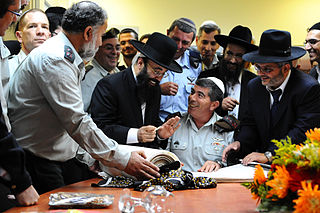
Yaakov Israel Ifargan, also known as the X-ray, is an Israeli Kabbalist rabbi and spiritual adviser who operates in Netivot, a town in southern Israel. He is known among his followers for his supposed healing and prognostic powers.

Bnei Baruch is a universalist kabbalah association founded by Michael Laitman in the early 1990s. It is estimated to have around 50,000 students in Israel, and some 150,000 around the world.
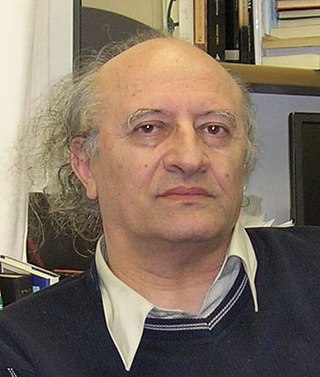
Moshe Idel is a Romanian-born Israeli historian and philosopher of Jewish mysticism. He is Emeritus Max Cooper Professor in Jewish Thought at the Hebrew University, Jerusalem, and a Senior Researcher at the Shalom Hartman Institute.
"Bar Yochai" is a kabbalistic piyyut extolling the spiritual attainments of Simeon bar Yochai, the purported author of the preeminent kabbalistic work, the Zohar. Composed in the 16th century by Rabbi Shimon Lavi, a Sephardi Hakham and kabbalist in Tripoli, Libya, it is the most prominent and popular kabbalistic hymn, being sung by Jewish communities around the world. The hymn is sung by Sephardi and Ashkenazi Jews alike on Lag BaOmer, the Yom Hillula of bar Yochai, and is also sung during synagogue services and at the Shabbat evening meal by certain groups. Incorporating expressions from the Tanakh, rabbinical commentaries, and the Zohar, the hymn displays its author's own mastery of Torah and kabbalah. According to Isaac Ratzabi, the song's use of "bar Yochai" is the probable reason for "bar Yochai"'s modern ubiquity.

Shimon Lavi was a Sephardi Hakham, kabbalist, physician, astronomer, and poet. He is credited with the founding of religious institutions and the revival of Torah study in Tripoli, Libya, in the mid-sixteenth century, where he served as spiritual leader and dayan for more than three decades. He authored a commentary on the Zohar titled Ketem Paz and the piyyut, "Bar Yochai", a kabbalistic hymn which became widely popular in the Jewish world. Libyan Jews consider him their greatest scholar.

Yehuda Liebes is an Israeli academic and scholar. He is the Gershom Scholem Professor Emeritus of Kabbalah at the Hebrew University of Jerusalem. Considered a leading scholar of Kabbalah, his research interests also include Jewish myth, Sabbateanism, and the links between Judaism and ancient Greek religion, Christianity, and Islam. He is the recipient of the 1997 Bialik Prize, the 1999 Gershom Scholem Prize for Kabbalah Research, the 2006 EMET Prize for Art, Science and Culture, and the 2017 Israel Prize in Jewish thought.
The history of Jewish mysticism encompasses various forms of esoteric and spiritual practices aimed at understanding the divine and the hidden aspects of existence. This mystical tradition has evolved significantly over millennia, influencing and being influenced by different historical, cultural, and religious contexts. Among the most prominent forms of Jewish mysticism is Kabbalah, which emerged in the 12th century and has since become a central component of Jewish mystical thought. Other notable early forms include prophetic and apocalyptic mysticism, which are evident in biblical and post-biblical texts.
huss.